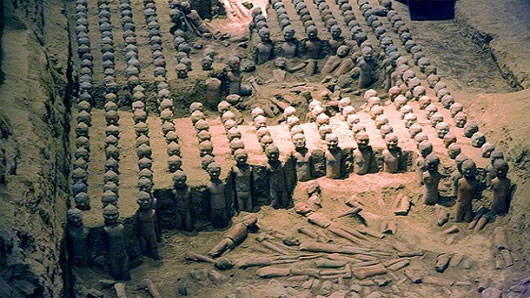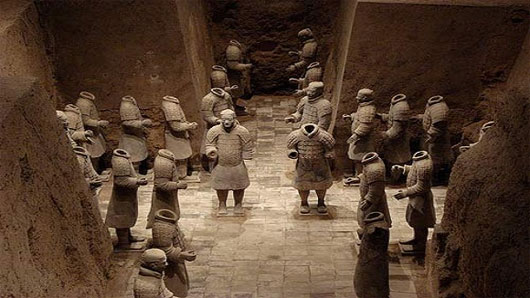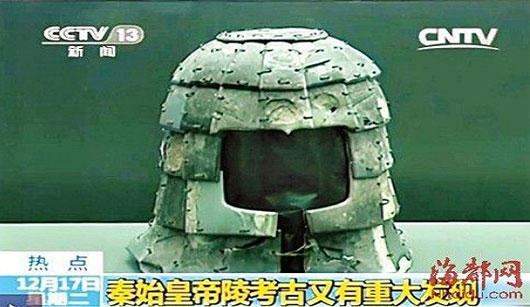Detecting Qin Shihuang's armor of terracotta warriors
According to the news of Qin Shihuang Museum, recently, archaeologists excavated in K9801 burial zone, covering an area of more than 13,000 square meters in the tomb of Qin Shui Huang, discovered traces of the area. This is no different from a "Weapon Museum".
>>>New hypothesis about terracotta army Qin Shihuang
The mausoleum 'Tan Thuy Hoang' is considered to be the largest tomb in the world, and is also one of the most peculiar tomb structures in human history. It lies deep underground in a hill in central China for over 2000 years, surrounded by a moat filled with mercury. The tomb holds the secret of the first Chinese emperor, who died in 210 BC, after uniting the six states into a single China.

K9801 depending on the burial area, located in the middle of the inner and outer layers, about 200 meters away from the tomb to the southeast, flat rectangle, the main part of the East-West axis length is 130 meters, the width of the shaft North - South 100 meters, the total area of more than 13,000 square meters, is the largest burial ground found in the area of the tomb of Tan Thuy Hoang ever.

Archaeologists have unearthed a large number of stone helmets and armor made of stone, woven with overlapping copper mesh, 87 pieces of armor, and 43 helmets.
Analysts, armor-making techniques must combine with the technology of processing gas at that time: first is the technique of making slate into armor , then honing into armor pieces, and then continue to drill and polish and then bond with bronze to get 1 armor.

Through experiments, if a hand-crafted person makes an armor, with 600 pieces, an average working time of 8 hours a day, you need to work from 344 to 444 days to complete. This means that to make a shirt, it takes at least a year.

The helmet and armor in the burial site are estimated to be made up of more than five million pieces of stone, suggesting the need to employ a large number of new workers. An estimated 700,000 prisoners of war and slaves participated in this complex and impervious construction. Later, they were killed to not reveal the secret of the tomb.
According to history books, in this gigantic tunnel, there will be thousands of stone armor and helmets. Currently, there are two excavated pits containing horse-drawn reins, parts for making horses and axes made of copper, arrows and other military items. Therefore, the experts said that should call the burial area of the Tomb of Qin Shihuang this underground arsenal.


According to Chinese history books, Qin Shihuang was born in 259 BC, the first child of King Qin, one of the six ancient Chinese states. These small countries have been fighting with each other for more than 200 years, then Qin Shihuang conquered them all and unified into a single Chinese country, claiming to be the emperor.
When passed away, Qin Shihuang was buried in one of the most magnificent tombs ever in China. It is a complex of tombs, palaces larger than a city, including underground caves full of troops, concubines, servants and "comfort" that the emperor needs for the next world. that.

Today, Qin Shihuang's tomb has become a tourist attraction and scholars from all over the world and the secrets within this emperor's tomb are still being discovered.
- Why not break the wall between terracotta warriors in Mausoleum of Qin Shihuang?
- New discovery about Qin Shihuang's grave
- Find the culprit who burned the tomb of Tan Thuy Hoang
- The mystery of the ancient Aztec warrior's cotton armor, against both the sword or the javelin
- Image: Excavating hundreds of 2000-year-old warriors
- The most famous ancient armor in history
- Decode the legendary armor of Japanese samurai
- The sophisticated weapon of the terracotta army in the tomb of Qin Shihuang
- Artists build terracotta army Qin Shihuang used to eat dog meat
- Discovering foreign soldiers in the tomb of Qin Shihuang
- New discovery of terracotta army in the tomb of Qin Shihuang
- 'Superman' armors
 Discovered an ancient centipede fossil 99 million years old
Discovered an ancient centipede fossil 99 million years old Discovered bat-like dinosaurs in China
Discovered bat-like dinosaurs in China Discovered a 200-year-old bronze cannon of the coast
Discovered a 200-year-old bronze cannon of the coast Discover 305 million-year-old spider fossils
Discover 305 million-year-old spider fossils